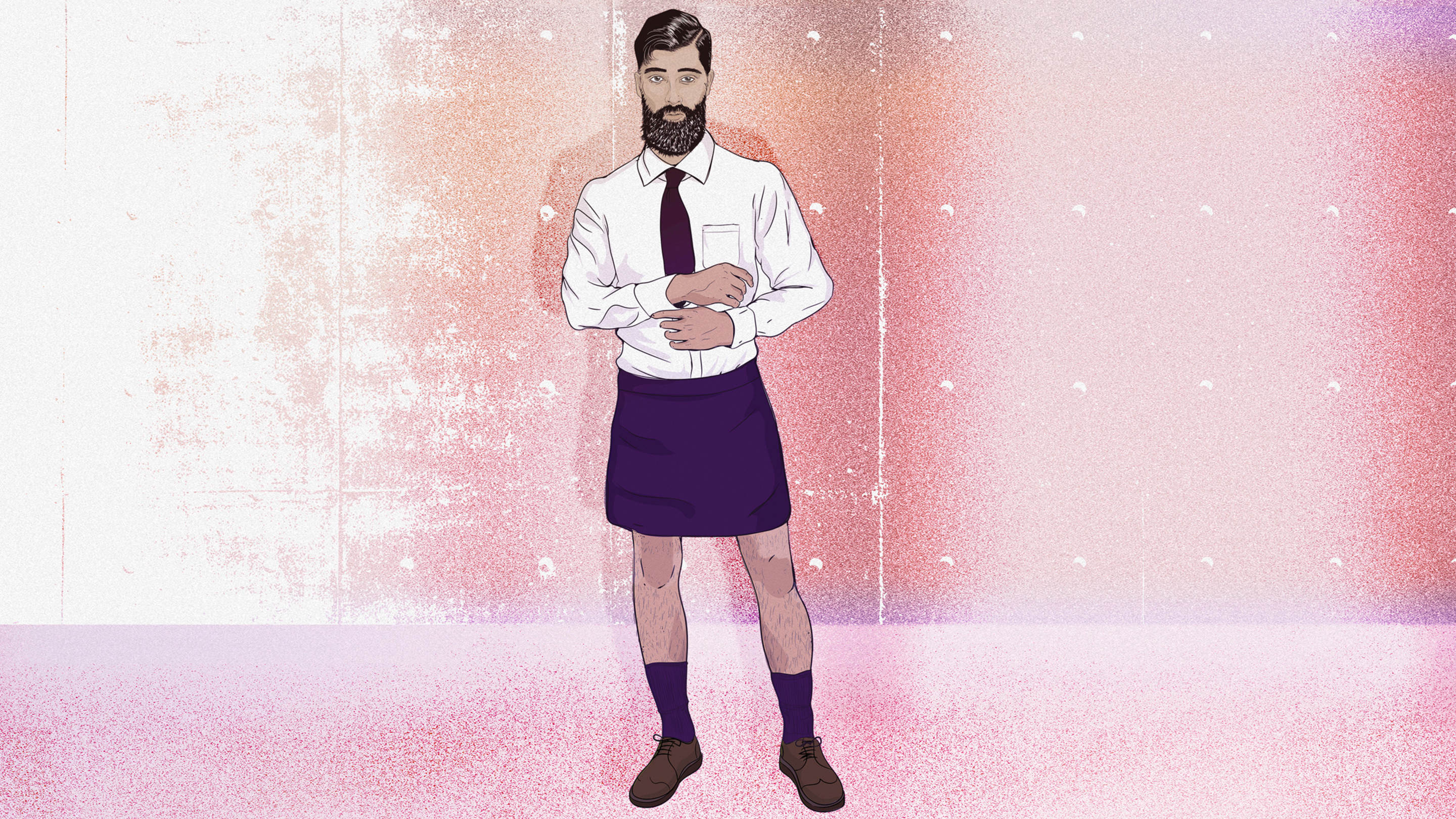
Why So Many Men Chase Skirts, But Won't Wear Them
The conversation around gender has ruptured open in the past year, leading society to take a long and hard look at the standards and parameters of masculinity. Political outrage and celebrity-led movements are making it more common for men to better inform themselves about gender and leaving them freer to reject archaic “manly” ideals than ever before.
Industries like fashion and beauty, however, have been experiencing a slower parallel shift for much longer. Since 2003, when the original Queer Eye introduced America to the metrosexual, men’s pursuit of traditionally “feminine” beauty ideals like shaped brows, buffed nails and dewy skin have become increasingly accepted in many normative circles—even encouraged in some industries like finance, where it’s especially crucial to appear wealthy. Following 2008, when formerly shorn men began growing so-called recession beards en masse, capitalism provided Bear Sterns severance-friendly oils, balms, and a slew of other positively dandy products and treatments. And in 2017, the grooming market became a billion business when Cover Girl and Maybelline collaborated with “beauty boys” Charles James and Manny Gutierrez respectively.
Still, there are limits to the man’s occupation of feminine domains, such as men’s wardrobes. This head-spinning period of social evolution has welcomed the concept of gender neutral designs, but nearly a century after Marlene Dietrich and Katherine Hepburn first led films in slacks and suiting, the general cis- and heteronormative male population refuses to wear skirts. The question is, “Why?”
Most people, whatever their politics or personal feelings on the matter, would likely answer something akin to “because gender roles.” It’s not exactly shocking that a male supporter of anti-trans legislation (or even just a dad type who goes clothes shopping, begrudgingly, once a decade) might balk at introducing a “woman’s” garment into his repertoire. Yet, even in fashion-forward and progressive circles, men’s discomfort manifests in myriad different ways, and with varying degrees of self-awareness. In truth, what makes a man, what constitutes a skirt and what such a garment implies are all more complicated facets of the question than many of us have ever considered.
It’s obvious why women would want to wear pants: built-in pockets, coverage, creative expression, and so on. But a point unanimously agreed upon by the male friends I surveyed for this article (all with pretty uniformly feminist leanings, but varying levels of sartorial interest) is that dresses and skirts also have at least one objective up on their bifurcated counterparts: their capacity for superior crotch ventilation. Still, ever susceptible to masculine mores, none of them plan to stray this summer from their trusted cargo or Bermuda shorts—and with warm weather fast approaching, now feels like an apt time to reexamine the overwhelmingly persistent view of fabric wraps and tubes as exclusively “feminine” garments.
By reducing people to only their bodies or surface-level presentation, it becomes easier to label all of those differences as biological rather than socially constructed.
Dr. Kristen Barber, a sociology professor, credits innate gender disparities for the reason behind the general male population's choice to steer clear of pant-less living. “As a culture, we’re very invested in this idea that men and women are innately more different than they are similar, which we use as justification for people having unequal resources and opportunities,” says Barber, who also wrote Styling Masculinity: Gender, Class, and Inequality in the Men’s Grooming Industry, an exploration of high-end barber shops and salons from the inside out. “By reducing people to only their bodies or surface-level presentation, it becomes easier to label all of those differences as biological rather than socially constructed.”
But it wasn’t always this way; in 1600s Western Europe, for instance, both men and women with the resources to do so wore heels, jewelry and extravagant wigs. Barber explains how in that cultural context, class stratification was less about separating people by gender, and more about aristocracy distinguishing themselves from people working their fields; and how now, with the grooming boom, there is a circling back to signifiers of upper class men’s wealth meant to distance generally straight, white, professional men from their lower income peers in more physically laborious lines of work. She describes the salons researched for
Styling Masculinity as environments built to remind clientele of their gender and status, be it through golf magazines, single malt whiskey, female stylists hired specifically for ogling or simply predictable displays of wealth by their fellow patrons. “The men I spoke to were usually searching for a certain aesthetic to convince investors or higher-ups of their trustworthiness in their white collar jobs,” Barber explains. “I talked to men who’d say things like, ‘When I go to my salon and I see other men with a Rolex or expensive shoes, I know it’s a place for men like me, or like who I want to be.’”
Besides the problem of these salons’ pointed exclusivity, it remains to be seen whether apparel retailers can replicate a similarly alluring and seemingly (if not always actually) non-normative consumer experience for men—especially considering the current state of brick-and-mortar stores. The vast majority of hyped-up “unisex” clothing lines have conspicuously left out even completely basic skirts and dresses, despite their being logistically simpler/cheaper to produce than the heathered sweats and hoodies, graphic tees, and occasional lumpy denim (all of which have been in men’s repertoire for as long as they’ve been in stores, and which women have been more or less “allowed” to wear for decades) that are constantly repeated instead.
Dannielle Owens-Reid, founder of Los Angeles brand Radimo, is intent on challenging the monotony of supposedly gender neutral clothing. “Clothing is inherently genderless, which is why I stock skirts and dresses,” says Owens-Reid. “But nobody believes me when I say my brand is gender neutral, because everyone who’s claimed the label so far has failed us—like mainstream brands who’ve hopped on this ‘trend’ without even bothering to understand its origins.” Owens-Reid says their approach of making “everything at Radimo… fucking normal” is informed by their own experiences as a fashion-conscious genderqueer person. “As I became more masculine in my gender and presentation, I started to notice there were femme looks that I really liked—they just weren’t styled in a way that I'd ever seen before,” they continue. “That’s when I realized that we can't sit around and wait for a fully ‘gender neutral brand,’ but we can work with or repurpose what already exists. Like, what’s so out there about a boy in a skirt? It's a piece of clothing and it's on a person.”
In recent history, at least, fashion has often been categorized almost exclusively as a feminine interest—so it’s no wonder that a big part Radimo’s business is persuading clueless or hesitant male customers to take similar sartorial risks. “I recently put a hetero gal pal’s husband in a pair of ‘women’s’ Jennifer Lopez brand pants, and he was amazed—like, ‘They fit perfectly!’” says Owens-Reid. “I just pointed at him and said, ‘See? That's why all clothes should be gender neutral!’"
But some men don’t need anyone else’s retail encouragement, like style blogger Kelvin Davis, who regularly discusses fashion and masculinity on his blog, Notoriously Dapper. “When I was younger, it wasn’t seen as acceptable for men to wear purple or pink,” says Davis, noting the role played by Cam’ron and other celebrities in creating that particular change. “Now you have people like Young Thug wearing a full-on dress on his album cover, but I haven’t seen men’s skirts actually trickle out into real life.”
For his part, Davis first says it’s never really crossed his mind to wear a dress or skirt; but later in our conversation, he expresses his interest in kilts. This seemingly small shift/brilliant marketing strategy of calling non-bifurcated garments marketed to men basically anything besides “skirt” or “dress” is utilized by brands like Utilikilt* (whose brand copy oh-so cheekily warns against pairing their product with puffy-sleeved shirts, or holding “leaf-blower duels” with other extremely manly, “SUBMIT” tee-donning men outside the Michigan Womyn’s Festival) and even, on occasion, a desperately euphemistic ASOS. Which brings us to the question of what qualifies as a skirt or dress across the world, and what that means for its wearers across cultures.
I wonder whether the skirt can become a way for men to start truly engaging on a political level, by criticizing narrow expectations and stereotypes of masculinity in a way that’s not ironic
Ahmed Ali Akbar is a former colleague and the host of See Something Say Something, a podcast covering “everything that American Muslims are talking about right now.” I’ve always perceived him to be style-conscious, unafraid of interrogating masculinity, and deeply connected to his roots—so I wondered why I’ve never seen him in a similar silhouette to the kurta he wore at his wedding in Pakistan. “One big issue is that there’s enough to worry about as a Muslim, or simply as a brown person, in the US these days,” says Akbar. “In a pretty white professional setting, I don’t necessarily want to other myself more than I’m already automatically othered. Outside the office, I could be straight-up harassed or worse. Honestly, it’s just a lot to think about on a day-to-day basis.”
Akbar wears some of his late mother’s overcoats, watches, and shawls as a way of feeling closer to her, but is frank about the “limits of [his] comfort” in both hemispheres. In South Asia, men commonly wear garments like kurtas and lunghis—but Akbar says his inherited shawls, “which are colorful in a way that reads as feminine in a Pakistani context,” have elicited the kind of anxieties and reactions there that something skirt-or dress-esque might do farther west. On this side of the Atlantic, his feelings about personally wearing anything skirt-shaped are still fraught—if not because of the aforementioned xeno/Islamophobia, then because of concerns relating somewhat obliquely to gender: his specific shape, and accordingly, how it compares to societally idealized proportions of men’s and women’s bodies. “I think a huge thing for me is how I feel about my body,” Akbar says. “I worry that a skirt would emphasize my hips, which I’m already self-conscious about, even in jeans.”
But what if you like the way you look in such garments? Christopher Soto is a poet based in Brooklyn, with a crop of dark brown hair, strong brows, and occasional matching scruff—as well as a penchant for skirts and dresses. But as a non-binary person who’s frequently read as male, wearing them in public often becomes a deeply upsetting predicament, if not an outright dangerous one. “I think gender is a narrative that cannot be divorced from its geographical and chronological constraints,” says Soto. “I used to wear dresses and skirts, but have stopped because my gender and conceptualized presentation feel unsafe at this moment and in this place.”
Even in an ostensibly progressive city where Pride is now its own lucrative industry, trans people are targets; trans femmes of color like Amanda Milan, Lorena Escalera, Islan Nettles and Soto disproportionately so. And for all of the violence from which cis men are generally insulated, wearing a dress or skirt is such a grievous tribal breach of masculinity by its more toxic practitioners that doing so could put said skirt-wearer in the crosshairs—figurative or literal—too. Women and femmes face any number of daily indignities and other forms of trauma, but death at insecure mens’ hands might top the list. Why put your body on the line when you could just wear chinos? “I wish I could wear a dress without such legitimate worry,” Soto says. “But in New York City in 2018, it could very well cost my life.”
This is the crux of the topic—the particular collision of classic flavor and trans-specific misogyny that continues to socially and economically subjugate skirt-wearers of all genders, if not literally kill them. It’s origin of of female impersonation, and the impetus for reclamation of queer identity through drag; the comedic anchor for films like Tootsie, Mrs. Doubtfire and the Madea series; and in addition to being broadly culturally sanctioned, is sanctioned legally in the many states that still support the Trans Panic Defense.
This attitude is not exclusive to conservatives or people from flyover country; it’s present every time a man pulls a dress off a store’s rack not to actually try it on for size, but to oh-so hilariously mock the idea instead. It’s present at events like the Slut Walk and Walk a Mile in Her Shoes marches, where men don over-the-top outfits ostensibly to protest the same misogyny they wind up committing in search of boisterous male camaraderie. It was present at Akbar’s college drag ball, to which he wore a skirt before reaching any modicum of understanding about drag’s political context. It’s enduring, and it’s pervasive—but it’s something Dr. Barber hopes will change with a burgeoning new generation of radical activists.
“Young people are protesting right now in really exciting ways that acknowledge race and class and gender, and I wonder whether the skirt can become a way for men to start truly engaging on a political level, by criticizing narrow expectations and stereotypes of masculinity in a way that’s not ironic like what Walk a Mile in Her Shoes has become,” says Barber. “And of course, there are outliers of all different ages—men who are sincerely invested in queering or reshaping their masculinity on more than just a surface level, and who can engage other men in meaningful discussions about gender and expression. Social media is a great place to do that, whether you’re a fashion blogger setting a trend or you’re simply sharing a piece of writing on your Facebook wall that contends with problematic aspects of masculinity.”
Iggy Pop famously said, “I’m not ashamed to dress ‘like a woman’ because I don’t think it’s shameful to be a woman.” But Iggy Pop has lived at various (and overlapping) times as both an actual masochist and a person of well-protected, high socioeconomic standing—the latter of which Davis expects, as with the grooming industry, is probably the most crucial catalyst for convincing a significant amount of men to try skirts for themselves. “There are as many forms of masculinity as there are men, and everyone should wear what feels right for them,” says Davis. “I do think skirts coming into the mainstream could help alter the course of where toxic masculinity is headed from here, but it’ll take people of a certain status to get that ball rolling. If LeBron James wore a kilt, it would be over; if Kendrick Lamar wore a kilt, it would be over.”
Whatever the case, the issue is urgent, and of more than simply sartorial consequence. This goes both for trans and non-binary people like Soto, and for families like Dr. Barber’s, whose dinosaur-loving daughter regularly shops in the “boy’s” section—but who worry about how to nurture and protect the male-assigned child they’re expecting, should that child want to wear tutus or play with dolls. “The fact is we live in a society where masculinity is not just the default, but is also given more value than femininity,” says Barber. “That’s why it’s at least generally pretty safe for girls to call themselves ‘tomboys’ and wear jeans, but a boy wearing a skirt or dress is viewed as a betrayal, which then becomes a justification for bullying or violence.
“We try in our house to emphasize that gender fluidity is okay,” says Barber, “but we can’t control the outside world—and it’s terrifying to potentially put your child in harm’s way.”






